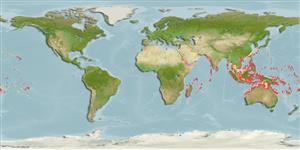>
Eupercaria/misc (Various families in series Eupercaria) >
Scaridae (Parrotfishes) > Scarinae
Etymology: Bolbometopon: Greek, bolbos-ou = onion + Greek, metopon = brow (Ref. 45335).
More on author: Valenciennes.
Environment: milieu / climate zone / depth range / distribution range
Ecologia
marinhas associadas(os) a recifes; intervalo de profundidade 0 - 40 m (Ref. 90102). Tropical; 34°N - 26°S, 32°E - 145°W (Ref. 116632)
Indo-Pacific: Red Sea and East Africa to Samoa and the Line Islands, north to the Yaeyama and Wake islands, south to the Great Barrier Reef and New Caledonia.
Tamanho / Peso / Idade
Maturity: Lm ? range ? - ? cm
Max length : 130 cm TL macho/indeterminado; (Ref. 9710); common length : 70.0 cm SL macho/indeterminado; (Ref. 9793); peso máx. publicado: 46.0 kg (Ref. 2334)
Espinhos dorsais (total): 9; Raios dorsais (total): 10; Espinhos anais 3; Raios anais : 9. This species is distinguished by the following characters: median predorsal scales 2-4 (may be obscured by hump); 3 scale rows on cheek, 1 (4-6), 2 (3-6), 3 (1-2); pectoral-fin rays 16 or 17; steep profile distinctive; nodules on teeth unique (Ref. 9793); prominent bump on forehead of adult (evident at least 25 cm TL); deep body 2.0-2.5 in SL, with depth increasing with growth; Colour of juveniles brownish to green with 5 vertical rows of whitish spots on side, the primary phase is a dull gray with scattered white spots, gradually becoming uniformly dark green (Ref. 90102, 1602).
Juveniles are found in lagoons while adults inhabit clear outer lagoon and seaward reefs up to depths of at least 30 m (Ref. 9710). They ‘sleep’ in caves and often in shipwrecks at night (Ref. 48636). They are usually in small groups feeding on benthic algae, live corals (Ref. 9710) and shellfishes (Ref. 58784). They sometimes ram their head against corals to facilitate feeding (Ref. 9710). The largest and wariest of the parrotfishes. Assessments showed their vulnerability to overfishing (Ref. 9710). Minimum depth reported taken from Ref. 128797.
Ciclo de vida ou comportamento de acasalamento
Maturidade | Reprodução | Desova | Ovos | Fecundidade | Larvas
Oviparous, distinct pairing during breeding (Ref. 205). Also Ref. 103751.
Randall, J.E., G.R. Allen and R.C. Steene, 1990. Fishes of the Great Barrier Reef and Coral Sea. University of Hawaii Press, Honolulu, Hawaii. 506 p. (Ref. 2334)
Status na Lista Vermelha da UICN (Ref. 130435)
Ameaça para os humanos
Harmless
Uso pelos humanos
Pescarias: espécies comerciais; Aquário: Espécies comerciais
Mais informação
ReferênciasAquaculturaPerfil para aquaculturaEstirpesGenéticaElectrophoresesHereditariedadeDoençasProcessamentoNutrientsConversão de massa
Ferramentas
Relatórios especiais
Baixar XML
Fontes da internet
Estimates based on models
Preferred temperature (Ref.
123201): 25.3 - 29.1, mean 28.2 °C (based on 2570 cells).
Índice de diversidade filogenética (Ref.
82804): PD
50 = 1.0000 [Uniqueness, from 0.5 = low to 2.0 = high].
Bayesian length-weight: a=0.01380 (0.00641 - 0.02973), b=3.03 (2.86 - 3.20), in cm total length, based on LWR estimates for this (Sub)family-body shape (Ref.
93245).
Nível Trófico (Ref.
69278): 2.7 ±0.41 se; based on food items.
Generation time: 11.0 ( na - na) years. Estimated as median ln(3)/K based on 2
growth studies.
Resiliência (Ref.
120179): Baixo, tempo mínimo de duplicação da população 4,5 - 14 anos (K=0.10).
Fishing Vulnerability (Ref.
59153): High to very high vulnerability (67 of 100).
Climate Vulnerability (Ref.
125649): Very high vulnerability (92 of 100).
Nutrients (Ref.
124155): Calcium = 19 [11, 34] mg/100g; Iron = 0.448 [0.252, 0.800] mg/100g; Protein = 18.9 [16.8, 20.7] %; Omega3 = 0.0876 [, ] g/100g; Selenium = 43.7 [22.6, 76.4] μg/100g; VitaminA = 40.3 [12.6, 120.3] μg/100g; Zinc = 1.14 [0.81, 1.69] mg/100g (wet weight);
